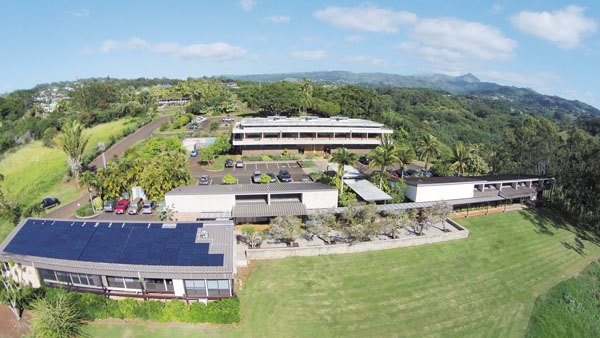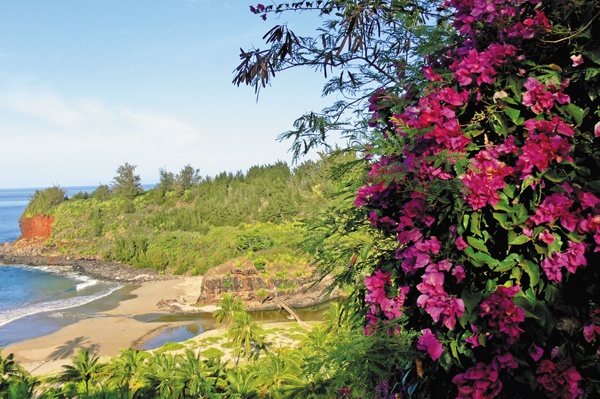Tropical plants are the key to our survival on this planet, says Chipper Wichman, director and CEO of the National Tropical Botanical Gardens. One third of them are threatened with extinction.
“The chair I’m sitting in is made out of wood, the shirt I’m wearing is made of cotton, the salad I’ll eat for lunch will be made from vegetables,” said Wichman.
That practical reality, including the need for trees and plants that enable people to breathe, is essentially why the NTBG, consisting of nearly 2,000 acres of gardens, exists today.
In the 1950s and 60s, five eminent citizens joined a movement originating in the 1800s to charter a not-for-profit botanical garden on Hawaiian soil.
The group included: Henry Francis duPont, whose family was known for its civic-mindedness; Waldo Malott, recently retired president of Cornell University; Marden Albright, former Director of National Parks; Robert Allerton, philanthropist; and Bigelow Sears, botanist and retired director of conservation, Yale University.
Their passion propelled a ground-breaking law incorporating the NTBG by Congressional Charter.
But long before that passage, a Kauai-born visionary, Juliet Rice Wichman, the grandmother of Chipper Wichman, was teaching him at the age of 6 about the Hawaiian culture, legends and plants that grew on the mountains of Kauai.
“I remember when she showed me a beautiful white hibiscus,” said Wichman.
Turns out the plant found on Mt. Haupu was a hybrid of a native species and became known as The Rice White Hibiscus, named after Wichman’s great grandfather.
That species died out 20 years ago. It was a critical extinction not taken lightly at NTBG, where visitors to the gardens can see a sampling of the world’s largest collection of federally listed endangered species.
“They (the plant species) are like our family members and when we see the last one gone, it’s heavy stuff. They are never coming back,” Wichman said.
Dedication
to discovery
The family land, 1,000 acres on the North Shore known now as the Limahuli Preserve, was lovingly cared for throughout many generations by Wichman’s family and eventually donated to the Institution. It is the NTBG’s largest conservation site for native Hawaiian plants.
NTBG is the research home for field teams who travel the Pacific, enduring at times life-threatening, wet and slippery cliff climbing expeditions, sometimes going for days without running water just to track down rare varieties.
“They really push the envelope to determine what plants are out there,” he said. “It takes decades of extremely dedicated field work and if a researcher discovers one or two species in a lifetime, they’re lucky.”
The mission of the NTBG is to enrich life through discovery, scientific research, conservation, and education by perpetuating the survival of plants, ecosystems, and cultural knowledge of Tropical regions. Its support comes primarily from donations and grants.
Dr. Diane Ragone, director of the Breadfruit Institute at NTBG, didn’t have any idea the global impact her discovery would have when a grant took her to remote areas in the Pacific Islands.
After reading missionary accounts and studies by scientists at the University of Hawaii library while studying for her PhD, Ragone said she had an “ah-ha” moment when it came to breadfruit trees. A dissertation topic was born.
“Some of the varieties I found were very, very rare,” Ragone said.
Visiting farms and gardens in backyards on the Cook Islands, Tonga, Tokelau and other islands in the Pacific, Ragone collected samples from 400 trees representing more than 200 varieties of breadfruit trees. That was nearly 30 years ago.
One of the finds from an abandoned collection she came across in Samoa turned out to be the “Fiti” variety.
“We’ve found the texture, taste and nutritional value to be better than some of the others,” said Ragone.
From her discovery, countless hours of research and collaboration with other preservation and educational forces, the five breadfruit varieties impact the lives of countless people in 16 countries, including Nicaragua, Tanzania, Costa Rica and Ghana, where breadfruit trees are growing to feed the hungry.
Examples such as Ragone’s make up the history at NTBG.
“It’s not a paycheck for the people who do this kind of research,” Wichman said. “It’s a cause and it is very rewarding. Our work has the potential to have a global impact on food security and hunger.”
The educational and entertainment components of the NTBG are powerful as well and offer visitors to the five gardens an opportunity akin to viewing a piece of art in a museum.
The breadfruit trees and Hawaiian flora as well as plants from islands elsewhere in the Pacific, have been meticulously tagged indicating exactly who collected them, when they were discovered, and where.
“That information is critical in conservation and research,” said Wichman.







